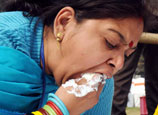
A 2012 joint report by UNICEF and the World Health Organization showed the importance of spending yuan on "spending a penny." The research indicated that 36 percent of China's population, or 477 million Chinese, have no access to safe toilets, classified as those which separate human excreta from human contact.
According to the report, a single gram of human excreta can contain 10 million virus particles and 1 million bacterium. Excreta can also lead to the spread of diarrhoea, one of the leading causes of death among children under five, and intestinal worms, which contribute to malnutrition and hold back physical and mental growth.
A lack of toilets remains one of the leading causes of illness and death among children. UNICEF estimates that around 2 million kids worldwide die each year from pneumonia and diarrhoea, illnesses which are largely preventable with improvements in water, sanitation and hygiene.
Zhang Min, head of Waina Elementary School of Waina Village, one of the pilot schools, was impressed to see how the project has changed all the school's 33 students, most of whom come from poverty-stricken families.
"In the old days, students didn't wash their hands after going to the toilet, simply because we didn't have hand-washing facilities," says Zhang. "Now they not only know how to wash their hands, but also how to save water by using flushing water to water vegetables."
Students are also influencing their parents and making more villagers aware of the importance of personal hygiene and environmental protection, according to Wei Jun, deputy director of the Guizhou Women's Federation, UNICEF's local partner.
"Some villagers told me that their children will remind them about washing hands before meals, and teach them how to wash hands. Some children also work out energy-saving solutions for the family," she adds.
After visiting the pilot schools, Gillian Mellsop, UNICEF's representative to China, was very impressed. She noted that the sites are a great model for other rural schools to copy.
"We are really delighted to see how the schools are implementing this new concept of what we call 'sustainable, sanitary and safe schools,' and I think these schools we see in Anlong County are really excellent models for other schools to copy," she says.
"Together with the Chinese government, we want to roll this model out across China so that more rural children can benefit from the approach."

















 'Collective children's weddings' held in kindergarten
'Collective children's weddings' held in kindergarten


![]()
